VHF 5/8wave vertical antennas
RE-A144V58/1
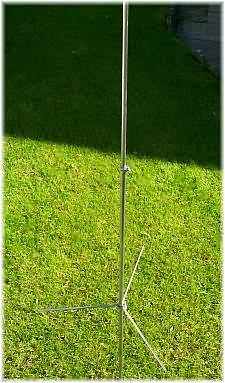
By Guy, de ON6MU
![]()
VHF
5/8wave vertical antennas
RE-A144V58/1

By Guy, de ON6MU
Schematic fig1
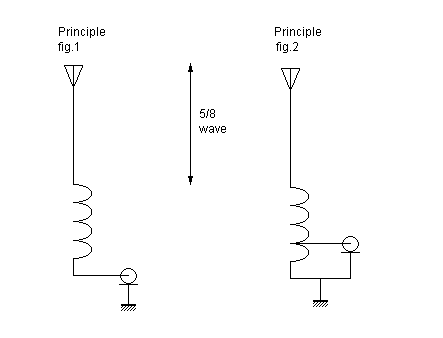
The 5/8-wave antenna
At VHF, both
the 1/4-wavelength monopole and the 5/8-wavelength monopole
antennas are widely used. The VHF 5/8-wavelength (144 Mhz)
vertical monopole has long held the reputation of providing about
a 3-dB gain advantage over the 1/4-wavelength vertical monopole.
The foundation of that reputation rests upon theoretical
calculations that show the longer monopole to have the derived
gain increase when both monopoles are set over a perfect ground.
A second factor contributing to the reputation of the longer
monopole for higher gain is the current distribution along the
element. Next Fig shows the distribution for both the long and
short monopoles, with the ground plane elements omitted for
clarity. The 1/4-wavelength antenna presents its
"half-dipole" current distribution curve, while the
5/8-wavelength antenna provides a "half-EDZ"
distribution curve. The peak current at a position well above the
top of the short antenna is said to give the longer monopole a
lower-angle of radiation and additional gain.
The third reason you may want to use the 5/8 wave vertical is to
obtain a lower angle of radiation.
Dissadvantage: needs a matching device at the base to match it to
the coax, it cannot be attached directly. This antenna has about
1.2 db gain over the dipole antenna and 1/2 vertical.
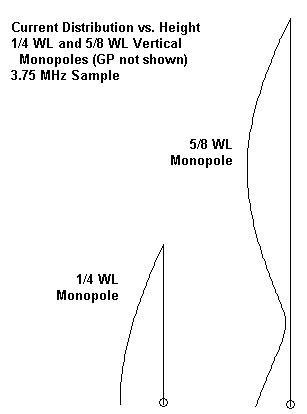
Parts list
Type 1:
alu or copper tubing of 1 meter 15mm tube and 1 meter 12 mm diameter tube
3 times 5 mm alu or copper tube of 22 cm
1 female PL 259 chassis
some silver wire of 1 mm
A robust PVC box of approx 30x50x18 mm and 1,5mm or more thick
a piece of hard
insulating material that snuggly fits inside the base
tube, like:
fiberglass, nylon, hard pvc, hard wood, bamboo etc... as
long as it's very strong, stress and weather resistant.
and a few innox hose
clamps
Type 2:
alu or copper tubing of 1 meter 15mm tube and 1 meter 12 mm diameter tube
3 times 5 mm alu or copper tube of 22 cm
+- 30 cm 2,5mm electrical installation wire
a piece of hard
insulating material that snuggly fits inside the base
tube, like:
fyberglass, nylon, hard pvc, hard wood, bamboo etc... as
long as it's very strong, stress and weather resistant.
some 50 ohm coax
and a few innox hose
clamps
Note: there are many ways to build your
antenna and I'm sure some can come up with better mechanical
designs then described here although the design and material used
here is cheap and easy to find.
Both types of 144 Mhz 5/8 wave antenna's described here has the
same radiationpattern and gain, but type 2 has the advantage of
being electrical (and DC) grounded and can disipate more power.
The antenna
type 1
RE-A144V58/1
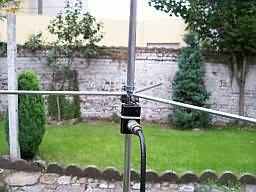
The antenna:
- saw the 1 meter 15 mm alu tube in half. One part (50
cm) will be used as a boom and the other as the first
part (also 50cm) of the antenna.
- saw some grooves (approx 1,5 cm) in the both halves of
the tube to allow a hose clamp to tighten everything up.
- the 1 meter 12 mm alu tube is fitted inside the 15 mm
base tube and can be hold tight with a hose clamp.
Measure from the base up 1,3 meters. You can alwyas tune
the antenna to its best SWR by sliding the top tube in or
out.
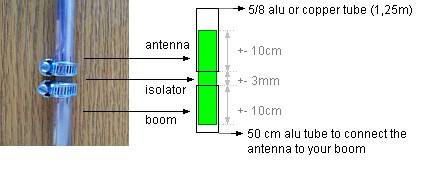
- saw a piece of that hard insulating material of your
choice and fit it 10 cm in the antenna and boom part and
leave a gap of 3 mm between them.
- hammer down one end of each of the 3 radials ( 3 x 22
cm) so it becomes a bit flatten. This will make things
easier to screw tight with the hose clamp. These radials
are fitted on the boom section.
The coil:

Wind 3,2 turns of silver plated copper wire of 1mm
thickness with an inside coil diameter of 8 mm (outside
10mm) and a the coil has a little spacing of approx. 0,2
mm.
Connect the
coil to the antenna and the other end to the centre of
your 50 ohm coax cable.
I used a little plastic box where I placed the coil and
the PL connector.
Specifications
antenna type 1
RE-A144V58/1
centre frequency: 145 Mhz
bandwidth: 2 Mhz
maximum tunable frequency range: 142...150 MHz +-
impedance: 50 Ohms
Gain: 4,1 dBi
maximum power using described components: 150watt +-
heigth: 1,25 m
The antenna
type 2
RE-A144V58/2
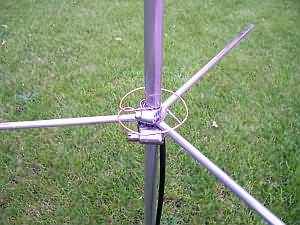
The antenna:
- saw the 1 meter 15 mm alu tube in half. One part (50
cm) will be used as a boom and the other as the first
part (also 50cm) of the antenna.
- saw some grooves (approx 1,5 cm) in the both halves of
the tube to allow a hose clamp to tighten everything up.
- the 1 meter 12 mm alu tube is fitted inside the 15 mm
base tube and can be hold tight with a hose clamp.
Measure from the base up 1,3 meters. You can alwyas tune
the antenna to its best SWR by sliding the top tube in or
out.
- saw a piece of that hard insulating material of your
choice and fit it 10 cm in the antenna and boom part and
leave a gap of 3 mm between them.
- hammer down one end of each of the 3 radials ( 3 x 22
cm) so it becomes a bit flatten. This will make things
easier to screw tight with the hose clamp. These radials
are fitted on the boom section.
- Fit the
braid of the 50 ohm coax to the boom section
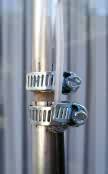
The
"ringostar" based coil:
Is made out of 26 cm of 2,5mm installation wire. Remove
the isolation of the wire and tin with a soldering iron
the entire wire. The coil is 1,2 turns and has a diameter
of 5 cm. One side is connected to the antenna and the
other side to the boom.
Find the 1:1
SWR position of the connection the centre of your coax
should be soldered to. Half way the coil is a good place
to start. Be sure your antenna length is measured up to
1,25 m. When you found the "sweat" spot solder
the the centre to the coil. You can alwys fine tune the
antenna for best SWR by sliding in or out the top tube of
the antenna.
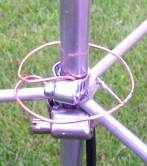
Specifications
antenna type 2
RE-A144V58/2
centre frequency: 145 Mhz
bandwidth: 2 Mhz
maximum tunable frequency range: 143...149 MHz +-
impedance: 50 Ohms
Gain: 4,2 dBi
DC grounded (no static buildup)
maximum power using described components: 250watt +-
Height: 1,25 m
Be sure to seal everything up to avoid moisture, corrosion etc...
More of interest: